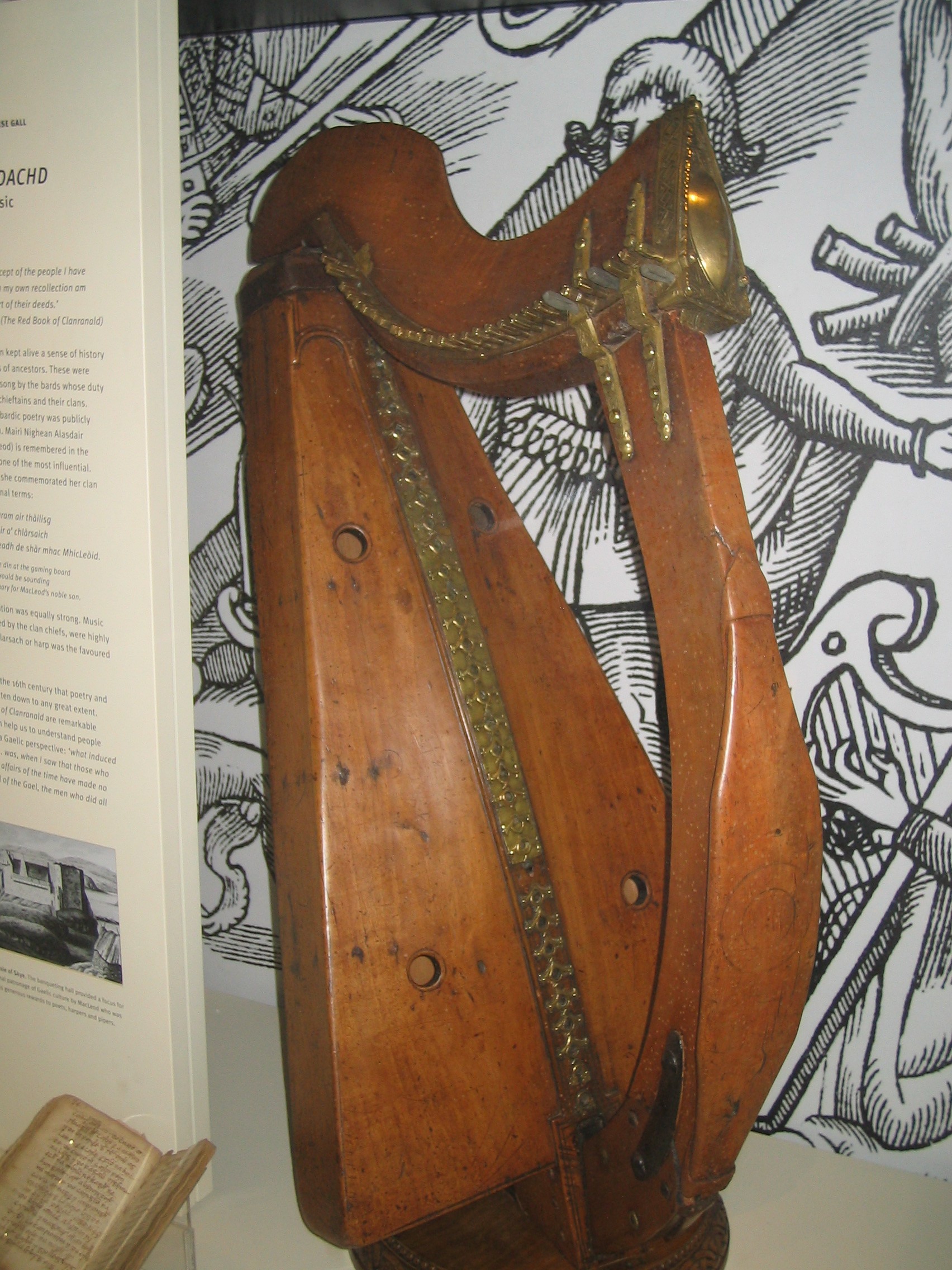Lamont Harp on:
[Wikipedia]
[Google]
[Amazon]
 The Lamont Harp, or Clàrsach Lumanach (also known as the Caledonian Harp or Lude Harp) is a Scottish
The Lamont Harp, or Clàrsach Lumanach (also known as the Caledonian Harp or Lude Harp) is a Scottish
 The Lamont Harp, or Clàrsach Lumanach (also known as the Caledonian Harp or Lude Harp) is a Scottish
The Lamont Harp, or Clàrsach Lumanach (also known as the Caledonian Harp or Lude Harp) is a Scottish Clarsach
The Celtic harp is a triangular frame harp traditional to the Celtic nations of northwest Europe. It is known as in Irish, in Scottish Gaelic, in Breton and in Welsh. In Ireland and Scotland, it was a wire-strung instrument requiring gre ...
currently displayed in the National Museum of Scotland
The National Museum of Scotland in Edinburgh, Scotland, is a museum of Scottish history and culture.
It was formed in 2006 with the merger of the new Museum of Scotland, with collections relating to Scottish antiquities, culture and history, ...
. It is believed to date back to the 15th century, and to have originated in Argyll
Argyll (; archaically Argyle; , ), sometimes called Argyllshire, is a Shires of Scotland, historic county and registration county of western Scotland. The county ceased to be used for local government purposes in 1975 and most of the area ...
. Along with the Queen Mary Harp
The Queen Mary Harp () or ''Lude Harp'', is a Scottish clarsach currently displayed in the National Museum of Scotland. It is believed to date back to the 15th century, and to have originated in Argyll, in South West Scotland.Keith Sanger and Al ...
and the Trinity College harp
The Trinity College harp, also known as "Brian Boru's harp", is a medieval musical instrument on display in the long room at Trinity College Dublin in Ireland. It is an early Irish harp or wire-strung cláirseach. It is dated to the 14th or 15 ...
, it is one of the only three surviving medieval Gaelic harps.
History
The Lamont harp was presented to the Robertson family of Lude 1460-1464 as part of a marriage dowry to Charles Robertson of Lude (or of Clune). The Lamont Harp was handed down in the Robertson family and remained at Lude inPerthshire
Perthshire (Scottish English, locally: ; ), officially the County of Perth, is a Shires of Scotland, historic county and registration county in central Scotland. Geographically it extends from Strathmore, Angus and Perth & Kinross, Strathmore ...
until 1805, when both the Lamont Harp and the Queen Mary Harp were sent to Edinburgh. In 1880 both clarsachs were deposited by a John Stewart of Dalguise in the National Museum of Edinburgh now the Museum of Scotland
A museum is an institution dedicated to displaying or preserving culturally or scientifically significant objects. Many museums have exhibitions of these objects on public display, and some have private collections that are used by researchers ...
, where they remain.
Appearance
The Lamont Harp stands 95 cm tall and 42.5 cm wide and is considerably larger than the 2 other medieval harps (Queen Mary and Trinity harps), but smaller than other surviving Gaelic Harps. The Lamont harp has very little decorative carving when compared to the other surviving examples, and was constructed with fine metal fittings, notably fox styled metal reinforcements between the pillar (''Lamhchrann'') and neck of the instrument, the metal head is beaten to imitate a gem setting and the square drives of the tuning pins are fitted to resemble cloves or rosebuds. The Lamont harp bears the inscription “Al Stew(art) of Clunie his Harp 165(0)” although this is too late a date for the original construction of the harp this may relate to the repair. The wood has been identified as hornbeam or English walnut. The pillar has distorted over time; the T-section reinforcement is shorter than on other early Gaelic harps, and the distortion does seem to have happened at the ends, where the pillar is wide but thin. In 1805 both the Lamont Harp and Queen Mary Harp were exhibited to the Highland society of Scotland and a history was commissioned and published by the author John Gunn in 1870.John Gunn “An Historical Enquiry respecting the performance of the harp in the Highlands of Scotland” Edinburgh 1807.Replicas
Replicas of the Lamont Harp have been attempted by many modern harpmakers, one of the difficulties being establishing the original form and string lengths due to the present distorted state of the instrument, and the natural desire to avoid the catastrophic fate of the original. It may be that during its lifetime the Lamont harp was re-strung with heavier, possibly brass wires, in order to change its volume or tone. It is speculated that the original stringing used gold wire in the bass, to achieve satisfactory tone, though this is still somewhat controversial. Ann Heymann and others have successfully strung medieval harps with gold bass strings. Replicas or reproductions have been produced.References
External links
{{commons 15th century in music 15th century in Scotland History of Argyll and Bute Collection of National Museums Scotland Culture of medieval Scotland Music of Scotland Individual harps